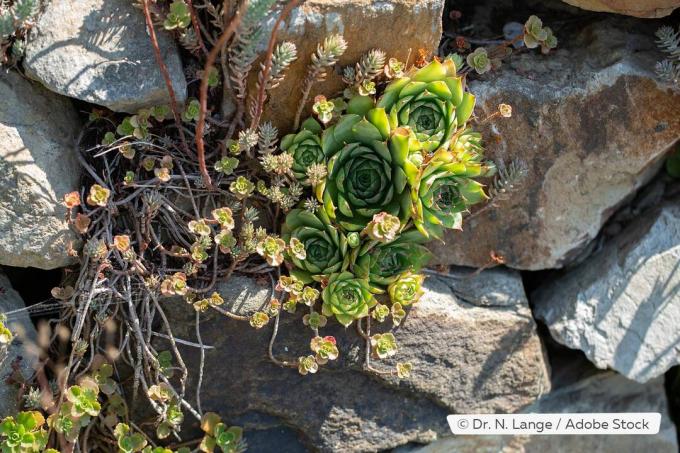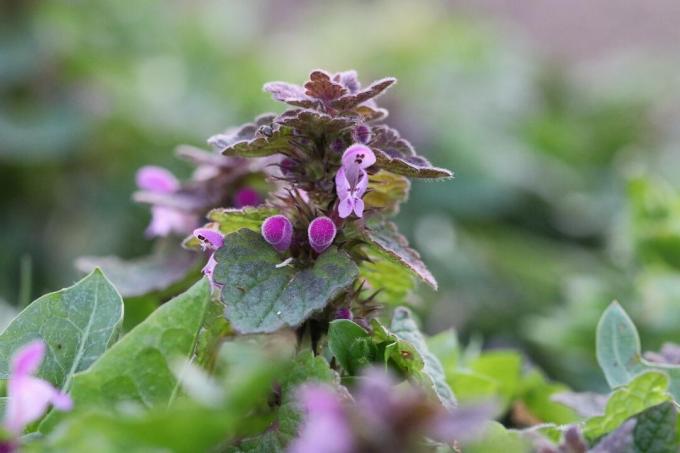
If you want to convert a gravel garden, you don't have to commit to a complicated garden concept. We present you with easy-care alternatives with which you can... Soften stone surface and make it lively.
To the point
- Remove separating surface
- Improve soil
- Choose easy-care plants
- Rock gardens recommended
- Implement dry concepts
Table of contents
- First of all: prepare the ground
- Dry location
- Rock garden
- Prairie garden
- Ground cover as a lawn alternative
- frequently asked Questions
First of all: prepare the ground
To one Gravel garden To convert, you must first prepare the soil for the new plants. The areas are not suitable for cultivating plants, even if you remove the gravel. The reason is the soil compaction that occurs due to the weight of the gravel and the use of moisture-proof films or garden fleeces.

The following steps are essential before you can use any of the alternatives below:
- Remove gravel
- Remove garden fleece or foil
- Incorporate sand and compost
- Mix everything thoroughly
- use a rake for this
The soil should then no longer be compacted and should have a fine, crumbly structure. Now the soil can absorb moisture again, is well ventilated and can therefore be used to cultivate plants. For some garden projects like a dry site, you don't even need to remove the gravel. There are numerous native plant species that are used to such locations. For others, the soil should rest for at least another season so that the soil can accumulate sufficient nutrients and form microorganisms.
From next spring it will continue as follows:
- Dig up the soil thoroughly
- pay attention to permeability
- Incorporate compost
- plant planned plants
A notice: You can use leftover stones after converting the gravel garden to create garden paths or foundations for smaller construction projects such as a wall.
Dry location
The alternative with the least effort is to convert the gravel garden into a dry location. This is an area with drought-resistant plants, similar to a dry meadow. As explained above, you don't even have to remove the gravel or you can only remove a small amount. As long as you have prepared the soil accordingly, planting can begin. To do this, you need suitable seeds that are suitable for dry locations.
The following plants are suitable for this:
- Braunelle (Prunella vulgaris)
- Real bedstraw (Galium verum)
- Real cowslip (Primula veris)
- Real veterinary vetch (Anthyllis vulneraria)
- sainfoin (Onobrychis viciifolia)
- daisy(Bellis perennis)
- Common yarrow (Achillea millefolium)
- Tangle Bellflower (Campanula glomerata)
- Bulbous buttercup (Ranunculus bulbosus)
- Crown vetch (Coronilla varia)
- Musk mallow (Malva moschata)
- Ribwort plantain (Plantago lanceolata)
- Pigeon catchfly (Silene vulgaris)
- Meadow knapweed (Centaurea jacea)
- Meadow daisy (Leucathemum vulgare)
- Meadow sage (Salvia pratensis)
- Meadow scabious flower (Knautia arvensis)
- Shaggy rattlepot (Rhinanthus alectorolophus)

You can either put together the seed mix yourself or purchase a ready-made mix. A special feature of such mixtures is the dominance of the respective species. Depending on location, light, weather and soil conditions, some plants emerge earlier than others. This can change over the years if you simply leave the resulting dry location to its own devices. If desired, you can also plant wild rose species, perennials and drought-resistant trees to make the area more attractive.
Once you have decided on a mixture, lay out the area as follows:
- Before sowing, rake the first layer of soil until it is crumbly
- Layer depth is about ten centimeters
- Sow seeds
- between 25 and 30 grams per square meter
- then water thoroughly
Rock garden
If you don't think the stone aesthetic is bad, but prefer a real garden, there's one Rock garden after converting the gravel garden. This is a garden concept that primarily comes from the Mediterranean or Alpine area. They are primarily used for sunny slopes and combine a variety of plants surrounded by areas of gravel or gravel. Of course, the soil is not compacted by a separating surface so that the plants can thrive without any problems. The stones store heat and release it to the plants overnight. For this reason they are suitable for many plants that have a lot Tolerate sun.
There are other design elements that lend themselves to the concept:
- large boulders
- Stone accumulations
- Dry stone walls
This creates additional living space for all kinds of animals, such as hedgehogs, Lizards or birds.

You can use a variety of Alpine and Mediterranean plants for the rock garden:
- Alpine aster (Aster alpinus)
- Alpine toadflax (Linaria alpina)
- Alpine rose (Pink pendulina)
- Blue pillow (Aubrieta)
- Blue diamond (Perovskia)
- Blue fescue (Festuca cinerea)
- Blue grape hyacinth (Muscari armeniacum)
- Elf crocus (Crocus tommasinianus)
- gentian (Gentiana)
- Rock alyssum (Alyssum saxatile)
- Cloves (Armeria caespitosa)
- Junker lilies (Asphodeline lutea)
- Cat paws (Antennaria dioica)
- lavender(Lavandula angustifolia)
- Upholstery phlox(Phlox)
- Cushion thyme (Thymus cherlerioides)
- Candytuft (Iberis)
- Butterfly bush(Buddleia davidii)
- Saxifrage (Saxifragia)
- Southern egret feather grass (Stipa pulcherrima)
- Roller spurge (Euphorbia myrsinites)
- Ornamental garlic(Allium)
- Quaking grass (Briza minor)
- Dwarf pine(Pinus pumila)

Once you have decided on a selection of plants, you can get started:
- Dig out an area of 40 to 50 centimeters
- Optional: Lay out a vole grid on the bottom of the pit
- Fill in drainage made of gravel or gravel
- Height of 15 centimeters
- a thin layer of sand follows
- then another layer of soil on top
- optional:Lay out weed fleece
- Fill in nutrient-rich topsoil
- Insert plants
- water thoroughly
Use additional stones to cover areas around the plants. The layer doesn't have to be high.
The following types of stone are suitable for this:
- basalt
- dolomite
- Gneiss
- granite
- Limestone (e.g. Jura)
- Sandstone
Prairie garden
Not everyone is familiar with a prairie garden, but it is an underrated concept due to its low maintenance and fairly easy implementation. This concept is ideal, especially for a dry and sunny location, as is often chosen for gravel gardens, and can be easily implemented after conversion. At first glance, prairie gardens may resemble a dry meadow, but they are not exactly the same. As the name suggests, the garden is designed similar to the American prairie.
However, the right conditions are important for implementation so that the drought-resistant plants can thrive without any problems:
- at least four hours of direct sunlight daily
- Avoid shadows
- well-drained soil
- airy
- nutrient rich

As long as the area meets these requirements, nothing stands in the way of the prairie garden. Implementation is just as easy because a prairie garden is made up of grasses, shrubs and perennials. The grass seeds are simply sown and grow wild, while you dive the other plants before planting and then put them in the ground. Prairie gardens are particularly attractive when many grasses grow close together and larger plants are dotted in between. Gravel or sand paths loosen up the look. If you want to use a prairie garden, you will now find a list of suitable plants.
The dry-site plants mentioned above are also suitable:
- Asters(Aster)
- Awesome splendor (Liatris spicata)
- Buffalo grass (Buchloe dactyloides)
- Honorary awards (Veronica)
- Common Sun Bride (Helenium autumnale)
- Gold balm (Monarda didyma)
- Gold diamonds (Solidago)
- Grove sage (Salvia nemorosa)
- Indian grass (Sorghastrum nutans)
- cockade flower (Gaillardia)
- Globe thistles (Echinops)
- mosquito grass (Bouteloua gracilis)
- Prairie Rose (Pink Arkansana)
- Giant feather grass (Stipa gigantea)
- Red spur flower (Centranthus ruber)
- Switchgrass (Panicum virgatum)
- Yarrow m (Achillea)
- Silver perovskies (Perovskia atriplicifolia)
- Sunflower (Helianthus annuus)
Ground cover as a lawn alternative
Lawns are not as easy to maintain as is often assumed. If you still prefer a walkable area, you can use ground cover. Ground cover plants have the great advantage that, in addition to being easy to care for, they permanently improve the soil and provide a buffet for pollinating insects. The soil does not dry out, retains sufficient moisture and can be expanded as desired. There are also many sturdy types that are suitable for walking on. However, ground cover plants are not suitable as a play area for children or animals, which is something to keep in mind.
You can use the following types of plants after converting the gravel garden:
- Lavender thyme (Thymus thracicus)
- Stonecrop (Sedum acre)
- Pennywort (Lysimachia nummularia)
- Polei mint (Mentha pulegium)
- Purple deadnettle (Lamium purpureum)
- Roman Carpet Chamomile (Chamaemelum nobile)
- Sand thyme (Thymus serpyllum)
- wood sorrel (Oxalis)
- Star moss (Sagina subulata)
- Carpet Verbena (Phyla nodiflora)
- Dwarf plumage pads (Cotula dioica)
- Cotoneaster(Cotoneaster dammeri)

When using ground cover, you can easily let your imagination run wild. Use flowering ground cover as a romantic path border or place individual splashes of color in a sea of evergreen. They are also well suited in combination with suitable perennials.
They are planted after soil preparation as follows:
- remove existing weeds (competition)
- Dive ground cover
- Root ball must be wet before planting
- Prepare a planting hole twice as deep and wide
- Ground cover insert
- fill with earth
- pay attention to ground contact
- water well
- mulch if necessary
Use treads or garden paths to avoid permanent foot traffic on the ground cover. This will prevent the creation of unsightly walkways.
frequently asked Questions
Not only plants are suitable for this. Create more retreats through wild corners, Insect hotels and Birdhouses. Bird baths are also popular over the summer. Place dead wood and clusters of larger stones in the garden to provide additional habitat for lizards or small mammals. You should also provide access in the fence, for example from hedgehogs are welcome to be used.
No, this is not necessary as long as you do not want to use deep-rooted plants or plants with high nutrient requirements. This variant is well suited for a dry meadow or a prairie garden, for example. To ensure permeability, you must cut the film at regular intervals over the entire surface so that the moisture can penetrate into the soil.
Recyclables are best suited for this, as gravel is a material that can be easily reused. Pay attention to the maximum free delivery quantity. You can also offer the gravel through classified ads or contact a construction company. They often collect the building materials free of charge or for a small fee. Of course you can order a construction waste container, especially for large quantities.



